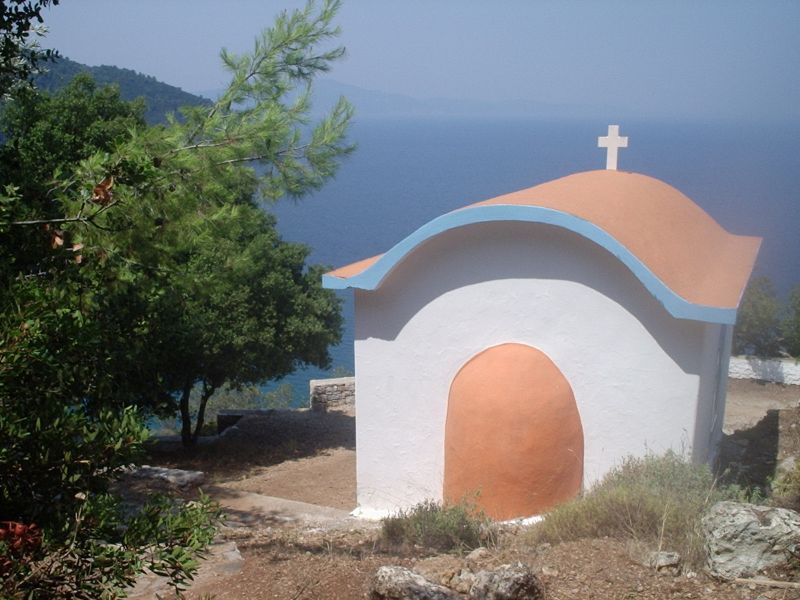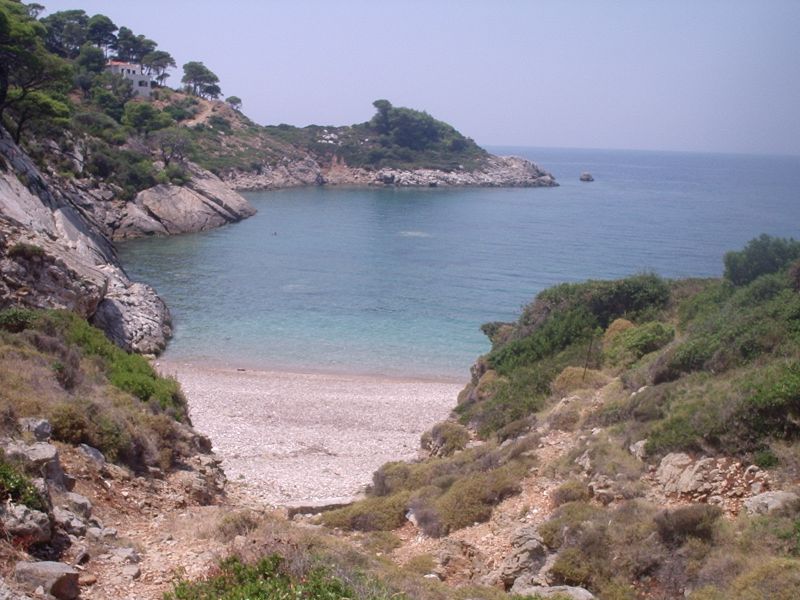From the coast at Tsoukalia, an asphalt road winds inland up a gentle incline to connect after 30 minutes walking to the area around Mega Nero. A little whiles before this point, at about 20 minutes from the coast, a dirt track heads off through the pines to the north in the direction of the little cliff top chapel of Agioi Anargyroi. It is a pleasant, if storyless little jaunt, taking in ever more satisfying glimpses of the sea through the pines until one arrives after another 20 minutes or so to the chapel itself.

As you can see, it is a singularly picturesque spot - although one, admittedly, which is endlessly repeated throughout the Aegean - and must be even more breathtaking in the softer colours of a summer evening when the sun dips down low on the facing horizon.
It is also a blessed spot in that it is situated in the general locale of some secluded little coves, offering the, by this time rather exhausted walker, an opportunty to cool their feet in the Aegean. To reach this area, known as Tourkoneri, one need only descend via a pleasant shady track through the pines which after ten minutes, will bring you to the grounds of a single house situated in an enviable poistion overlooking a sheltered bay.

You can just glimpse this house in the top left hand corner of the above photograph. However, one cannot see this little cove, where I swam naked for half an hour or so in complete isolation, from the path leading down from Agioi Anargyroi. In fact, on arriving at the coast by this path, one is met by a dirt road which, if followed, would take one back up inland eventually to meet up with a bigger dirt road running parallel to the main road through an area know as Rahes. This would be my route home; but before then, I fancied exploring the hidden inlets and coves on this part of the coast... but how?
The answer came, as usual, after a brief period of curiosity.
Leaving the house, I walked along the dirt road past the baking bodies jostling for a little more room on the tiny cove which was Tourkoneri proper, and up and a little inland on the dirt road. Sensing that this was the same road marked on the map and that it would soon take me back in the direction of home, I sought a little shade under a pine tree growing at the edge of the road to get my bearings once more. Looking up from my map at one point, I saw that I was actually sitting on the top tier of a stepped olive grove which wound around a little cove in an elegant arch, hugging the horse-shoelike contour of the land. Not only this, but there, a couple of tiers down below me and only just discernable, was a path which followed the countour of the olive grove first inland then back out again on the finger of the opposite peninsula. Once again, a little disinterested curiosity had shown me the way forward.
Getting up and following this path, I was led to a gate beyond which the path forked, with one route heading up onto a cliff-top path and another heading down the peninsula in the direction of the bay. Taking this latter path, I found myself after 5 minutes at the secret cove snapped in the photograph above and, confident that I would have the place to myself for a good while, stripped off for a highly refreshing and much needed skinny dip.
Refreshed and ready for yet more walking, I took to the cliff top path in good time to admire the view of a tourist kaiki gliding into the bay below me, the passengers of which would have got an extra little thrill if they had arrived five minutes earlier. From here, the path descended once more to the coast for the remainder of the walk, all the way to Megali Ammos beach in fact, alternately looping around little coves and out onto the rocky fingers of interposed peninsulas.
All in all, it was a beautiful and none-too-demanding stretch to top off what had been a long day's walking. So long in fact that when I got to Megali Ammos, I realised that this was as good a place as any to call it a day and head back to Patitiri on the wide road through Rahes...
... A route that I would revisit the next day on my way to Steni Vala.
As you can see, it is a singularly picturesque spot - although one, admittedly, which is endlessly repeated throughout the Aegean - and must be even more breathtaking in the softer colours of a summer evening when the sun dips down low on the facing horizon.
It is also a blessed spot in that it is situated in the general locale of some secluded little coves, offering the, by this time rather exhausted walker, an opportunty to cool their feet in the Aegean. To reach this area, known as Tourkoneri, one need only descend via a pleasant shady track through the pines which after ten minutes, will bring you to the grounds of a single house situated in an enviable poistion overlooking a sheltered bay.
You can just glimpse this house in the top left hand corner of the above photograph. However, one cannot see this little cove, where I swam naked for half an hour or so in complete isolation, from the path leading down from Agioi Anargyroi. In fact, on arriving at the coast by this path, one is met by a dirt road which, if followed, would take one back up inland eventually to meet up with a bigger dirt road running parallel to the main road through an area know as Rahes. This would be my route home; but before then, I fancied exploring the hidden inlets and coves on this part of the coast... but how?
The answer came, as usual, after a brief period of curiosity.
Leaving the house, I walked along the dirt road past the baking bodies jostling for a little more room on the tiny cove which was Tourkoneri proper, and up and a little inland on the dirt road. Sensing that this was the same road marked on the map and that it would soon take me back in the direction of home, I sought a little shade under a pine tree growing at the edge of the road to get my bearings once more. Looking up from my map at one point, I saw that I was actually sitting on the top tier of a stepped olive grove which wound around a little cove in an elegant arch, hugging the horse-shoelike contour of the land. Not only this, but there, a couple of tiers down below me and only just discernable, was a path which followed the countour of the olive grove first inland then back out again on the finger of the opposite peninsula. Once again, a little disinterested curiosity had shown me the way forward.
Getting up and following this path, I was led to a gate beyond which the path forked, with one route heading up onto a cliff-top path and another heading down the peninsula in the direction of the bay. Taking this latter path, I found myself after 5 minutes at the secret cove snapped in the photograph above and, confident that I would have the place to myself for a good while, stripped off for a highly refreshing and much needed skinny dip.
Refreshed and ready for yet more walking, I took to the cliff top path in good time to admire the view of a tourist kaiki gliding into the bay below me, the passengers of which would have got an extra little thrill if they had arrived five minutes earlier. From here, the path descended once more to the coast for the remainder of the walk, all the way to Megali Ammos beach in fact, alternately looping around little coves and out onto the rocky fingers of interposed peninsulas.
All in all, it was a beautiful and none-too-demanding stretch to top off what had been a long day's walking. So long in fact that when I got to Megali Ammos, I realised that this was as good a place as any to call it a day and head back to Patitiri on the wide road through Rahes...
... A route that I would revisit the next day on my way to Steni Vala.







